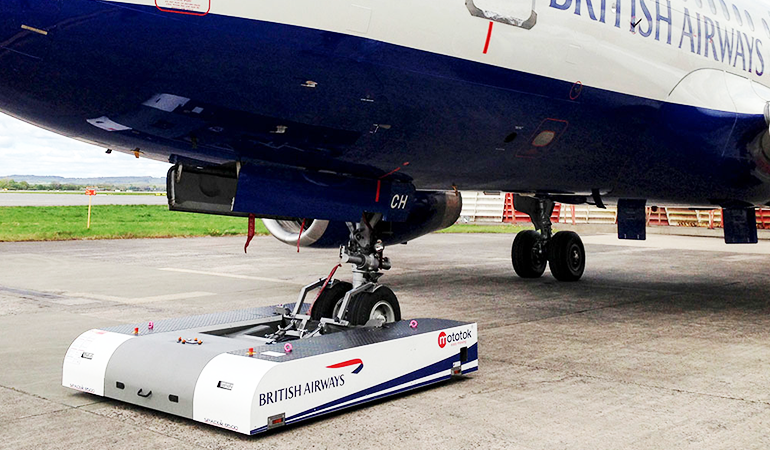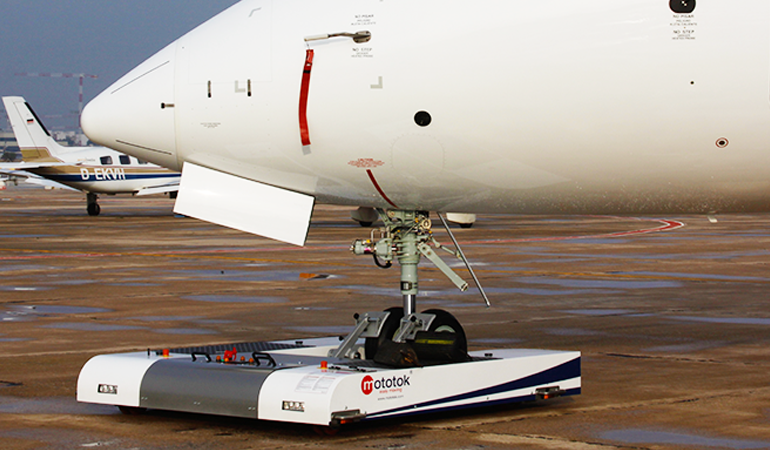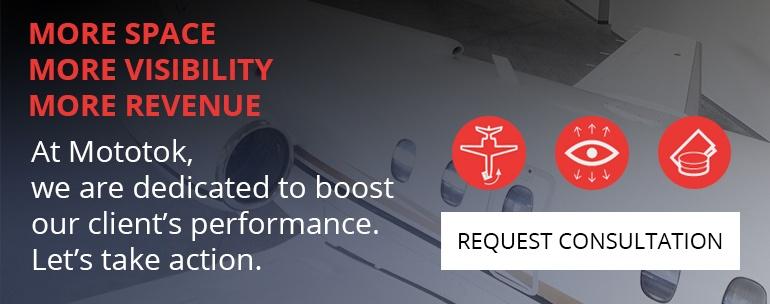The world of aircraft tugs has changed very little over the past several decades, with tugs remaining essentially unphased by advances in technology. Gasoline engines have largely given way to diesel power, but beyond that aircraft tugs are virtually unchanged since the mid-20th century. This is largely attributable to aircraft tugs being such a specialized piece of equipment that changing them is largely overlooked since the designs have worked as required for many years. That’s why remotely controlled aircraft tugs are all the more a revolution for aircraft ground handling.
The specific advantages of a remotely controlled tug over a traditional tug
Traditional tractor-style aircraft tugs have continued to weather the test of time due in no small part to the lack of creative alternatives in the market. Aircraft tugs are unimaginative and are meant to fill one specific role, which is pushing a very heavy object at a very low speed. As such, they are geared extremely low and are incredibly heavy. Since they are geared so low and spend much of their time idling, fuel economy suffers as does their environmental impact in general. Internal combustion engines take considerable time to warm enough for efficient operation, which is both costly and environmentally taxing. For high tempo operations it makes the most sense to allow the vehicle to sit idling, which increases operational costs, as well as reducing the mean time between servicing which is based on operating hours.
Personnel costs of conventional aircraft tugs
Traditional aircraft tugs require relatively large teams of ground personnel for each tow operation, personnel which otherwise would not necessarily be available or in the immediate vicinity of the operation. Henceforth, the hard requirement to have a team available for each tow places an unnecessary strain on the overall ground operation.
Remotely controlled tugs offer very distinct advantages over traditional counterparts which will yield immediate gains. First, the crew requirement drops from a minimum of four down to one person because the operator is able to operate remotely with no further assistance needed. Since he no longer has to be within arms length of the aircraft tug, the operator has the mobility to walk around to any portion of the aircraft and personally monitor the tolerances.
Second, there is a truly significant learning curve associated with operating a traditional aircraft tug. When manufacturers started moving towards towbarless tugs, it was a move in the right direction in terms of simplicity of movement, but the tugs were still driven in a traditional manner with the operator sitting on the tug and driving it like a tractor or truck. Hence the team size necessary for a tow remained the same; the only key advantage was that the confusion of using a tow bar was removed.
These manned units are certainly fast to affix to the aircraft being towed for the sake of push backs, but again the requirement for a full team still remains. While other leading manufacturers claim “excellent visibility” for their units, this is highly subjective and contextual. Compared to looking through a wall or a tree, then yes, conventional units are indeed superior. But in terms of actual working visibility, traditional tugs are basically only good in one direction which is forward. They are made to offer visibility of the pintle hitch and tow bar, but the driver ends up so close to the body of the aircraft that he cannot see much beyond it. Also, if he must tow the aircraft using the rear pintle hitch rather than pushing using the front hitch, he cannot see the rear hitch at all, nor can he monitor the aircraft very well during the tow. This is what necessitates a tow team supervisor, which merely adds another element to the operation which is completely avoidable when using a remotely operated aircraft tug.
How is a remotely controlled tug a better option than a traditional manned unit?
The prevalence of diesel tugs still remaining the mainstay of airline and airport operations is attributable to the lack of any radical improvements in recent memory. It seems akin to reinventing the wheel; why bother investing in changing something simple which has worked relatively well for decades? Complacency has allowed operators in the industry to accept mediocrity when technology provides a much better solution.

Remotely controlled aircraft tugs are an enormous improvement in terms of efficiency, productivity, environmental improvement, and manpower. They win in all conceivable metrics. As mentioned previously, manned tugs are not intuitive, nor are they user friendly. For one thing, they are not particularly safe to other members of the team. More than just a few individuals have lost digits on their hands while closing the pintle hitch around the tow bar. Visibility in traditional tugs is very limited, whereas remote tugs have unlimited visibility.
Not only remotely controlled but also towbarless
Traditional pushback tractors attach to a tow bar which then attaches to the aircraft nose landing gear, making two pivot points in the towing process, which is unlike any other towing task in the world which essentially means that no previous experiences driving trucks, heavy machinery, or agricultural equipment will translate to the task at all. There are no tangible safety features built into a traditional aircraft tug other than the attentiveness of the operator and crew. Members must physically attach the tow bar to the aircraft and the tow bar to the tractor which exposes them to numerous pinch points and crushing hazards.
By stark contrast, a remotely controlled tug never directly exposes the operator to precarious positions between the machine and the aircraft. Instead, he is allowed to maintain a very safe distance and observe as the aircraft nose tires are captured by the tug. He is never anywhere in harm's way during the process. Because the remote tugs have a very low profile, he can safely observe every critical movement of the operation with ease and transparency. The remote tug is battery operated which makes it virtually silent to operate. Diesel tugs on the other hand are extremely loud in an environment which suffers from noise pollution to begin with. While ground operators will never be able to eliminate all sounds, they can certainly mitigate those which are practical.
Are remotely controlled tugs safe to use?
A better question to ask is whether or not traditional aircraft tugs are safe to use. Remote tugs are equipped with kill switches which halt movement immediately. They are also equipped with programmable speed limits, and just as importantly, oversteer limits. Traditional aircraft tugs have no such safety features. Since steering limits differ from aircraft to aircraft, you must hope that the warning lines are marked on the aircraft fuselage. If not, severe damage is all but guaranteed to occur to the aircraft when oversteered. Most standard operating procedures call for the tow vehicle operating no faster than the slowest walker, but a tow team will likely consist of four or five members. That is a lot for the supervisor to monitor all the while watching active taxiways for traffic. Instead, the remote tug operator serves in the capacity of all positions and functions of a tow operation, effectively eliminating confusion caused through poor communication in an industrial environment, or caused by inexperienced personnel on the job.
Remoteky controlled aircraft tugs have another very important safety feature which is easily overlooked. Remote tugs place a huge amount of weight from the aircraft directly on top of their very wide (100mm) drive wheels. This allows virtually unbridled traction in unfavorable surface conditions, and also allows for excellent braking action. Conversely, tractor-type tugs struggle with traction and braking due to the very nature of the design. The tow vehicle must have adequate mass to do a couple of things: first, it must have enough weight to establish forward movement; second, it must have adequate mass to achieve suitable braking action. While the remote tug is certainly no welterweight, it is still able to be a lighter unit than a traditional tug rated for comparable aircraft because the remote tug leverages the mass of the aircraft itself to achieve the desired result.
How is a remote controlled aircraft tug going to revolutionize your ground handling?
It is not difficult to establish the numerous advantages of a remotely controlled tug over a diesel push back tractor tug, but what are the tangible benefits which create bonafide return on investment? The remote tug offers instant benefits in the form of allowing the operator to fully realize space utilization in their hangar(s). Tractor tugs simply cannot execute turns without inducing significant wingtip movement (recall the aforementioned multiple pivot points). This also destroys any possibility of truly precise aircraft movements in extremely tight quarters. The remote tug excels in such environments. Since there are no gears involved, the remote tug is very smooth in operation and can quite literally stop on a dot. Heavy, bulky traditional tugs do not stop on a dot. In fact, they usually shudder and grind to a halt a meter or more after the application of brakes. There is also the unavoidable lag between the supervisor ordering the driver to halt and the driver actually depressing the brake pedal. This unquestionable supremacy allows the remote tug to utilize up to 40% more hangar space than their counterparts. Talk about revolutionizing the industry.
Conclusion to remotely controlled aircraft tugs
Buying an aircraft tug is a big decision; your operation is going to rely on it in all weather conditions, day and night, every day of the year. Tugs are not cheap, either. You will be depending on this piece of machinery to safely and efficiently maneuver the most expensive asset in your inventory, and in the case of airline push backs, they will be doing so with the most precious of cargo. Your operation deserves better than the status quo, and should not be bridled with the same antiquated technology that has been used for the last half-century. Modern technology has provided a platform for far better efficiency, safety, and performance and you owe it to yourself to take it in serious consideration. Do not continue to flush away earnings with an inefficient operation; take the next step to revolutionize your operation today and get in touch with us!



Comments